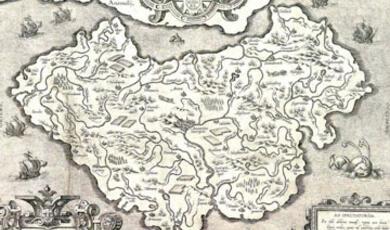14 May 2014
The Iconography of Blindness:
How artists have portrayed the blind
Professor William Ayliffe
Iconography simply means writing with images. Throughout history there have been stories of blind people, some of these told through the medium of sculpture and painting. Indeed images of blindness are extremely common.
Representing blind or partially sighted people in static images presents several problems. How is the artist going to signal that the character in the image or sculpture is blind? Are the viewers going to recognize these cues?
In fact, very early on in the history of art a fixed set of typical features were used specifically to denote blindness, and interestingly these are still used today.
As inventions, such as spectacles, particularly with dark lenses, became commonplace, artists were able to add these new devices into their pictures denoting visual impairment, whilst still retaining the older, established iconography to reinforce the power of the image.
We can recognize visual impairment in paintings and sculptures by looking at the eyes themselves. Blind eyes could be depicted as closed, whitened or asymmetrical. They may be in hollowed out sockets or being touched. A particularly potent iconography is the opening of eyes after a healing.
Several non-ocular clues are often also used by artists. For instance, the stance of the subject is important. They might be painted with arms held out feeling their way around, with an unsteady gait or less obviously with an uplifted head. Often blind subjects are painted wearing a broad brimmed hat.
Remember to look carefully at bedridden figures, they may be painted as blind and observe if there is a character who is unoccupied in an otherwise busy scene.
c587BC: Zedekiah is chained and brought
before Nebuchadnezzar 1670: Petrus Comestor's
"Bible Historiale" Bodleian
Note the blinded King is the only still person
in a scene full of conversation
Smithfield Decretals (British Library Royal
10 E IV), c 1340
Folio 110r: bas-de-page scene of a blind
beggar and his dog.
France, ?Toulouse
Finally blind people are nearly always carrying some prop. This might be a musical instrument, a cane or in more modern images dark glasses.
Sometimes the visually disabled person is being led by another person, a child or a dog. Such representations are surprisingly ancient and common.
In The Old Kingdom, ancient Egyptians became skilled at depicting realistic eyes for their statuary using models crafted from rock crystal.
One of these from the 5th dynasty deliberately portrays a man blind in one eye from mature cataract.
BC 2300: sycamore Statue of Ka-aper:
BC 1345: Bust of Nefertiti
More famous is the bust of Nefertiti dating from 1345BC. These eyes are not modeled but painted, and the intention of the artist is clearly to portray the queen as blind in the left eye.
In 1768, James Bruce discovered the tomb of Ramesses III. On the walls were images of blind harpists, the eyes painted as slits.
Blind musicians are in fact a common theme in ancient Egyptian art and at least 47 tombs in the Theban Necropolis contain such images.
In fact, blind musicians remained a potent and frequently used motif often employed in baroque and Victorian art and still in use today with iconographic images of pop star Stevie Wonder being instantaneously recognizable to a modern Western audience.
Apart from illustrations of the stories of famous blind people in the Bible, and later on stories from ancient literature, many images of everyday scenes with blind people illuminate the pages of mediaeval writing and appear on the walls of their churches.
Poverty and disability were part of every day life and contributed fully to the functioning of those societies. Most people with disabilities were cared for by families if available. Those without families might form confraternities, such as the hospices for blind priests.
The final resort was begging. Giving alms and charity was considered to be a way to salvation, so paradoxically the crowds of blind beggars at the city gates or on the steps of the church were actually needed in Mediaeval times.
Being everywhere it is not surprising that blind people were depicted frequently in paintings of this time. However the attitudes to blind beggars changed with increasing hardship of the mediaeval world following the Black Death and depredations of long terrible wars. The concept of the deserving and non-deserving poor recognizable today has its origins in this period.
Various tests were used to identify if the person seeking alms was indeed disabled. Blind people became the object of ridicule and exploitation.
The religious attitude to disability particularly blindness varied and was used to suit the circumstances of the day. On one hand there was the notion of blindness being caused by sin, on the other was compassion influenced by the biblical stories of healing the blind.
Illustrating stories from the Bible to illiterate audiences became a major source of ideas for illustrations and sculptures of blind people.
Tobias curing his father
A particularly well preserved example is the portal carving illustrating the story of blind Tobit at Chartres Cathedral.
Earlier examples of Byzantine mosaics depicting Jesus healing the blind are potent and beautiful images. They may not have been merely illustrations of a story but powerful symbols of the metaphorical removal of spiritual ignorance to replaced by the light of the faith in God.
C6th: Christ Heals the Two Blind Men on the Road to Jericho;
Basilica di Santa Pollinare Nuovo, Ravenna
1570: El Greco: Christ healing a blind man by anointing his eyes
As such the popularity of the Damascene moment and Saul’s conversion to Christianity amongst Renaissance and Baroque painters becomes understandable.
The Conversion of St Paul; Fra ANGELICO; c. 1430;
The Conversion on the Road to Damascus; CARAVAGGIO; 1601
The power of a saint’s relics to relieve suffering and even cure blindness was an important attractant to many shrines, who’s wealth depended on the ability to extract money from pilgrims.
To this end gorgeous churches were constructed to house the relics and statuary, stained glass and paintings used to emphasise the miraculous powers of the particular saint.
The miracles of St Thomas, gruesomely portrayed in beautiful stained glass at Cantebury and a century later the mazing stained glass window at York Minster celebrating the somewhat controversial life of the local Saint William are easily accessible examples.
Blinding of Ealward: Trinity Chapel Canterbury 1213
William heals a blind woman: York 1440.
Around this time sources other than the Bible and saintly healing were used as ideas for art. In particular the rediscovery of non-religious ancient Greek texts, filled with stories of blindness, punishment and revenge were inspirations for some of the greatest paintings of all time.
Jacques-Louis David:
Belisarius asking for alms 1781
It is reasonable to ask what was the reason for the frequency of depictions of blindness and disability in former times. Certainly one factor is that blindness was indeed more common in a world with untreated and untreatable disease, accidents, constant warfare and punishment blinding. But this does not entirely explain the near absence of images depicting blindness in stark contrast to their abundance in former centuries.
Perhaps we should invert the question and challenge why disabled people have been airbrushed out of the modern world that forcefully promote an unrealistic culture of body beautiful. There seems to be little place for the blind or disabled in our warped culture that devotes so much energy to what is trivial in life.
The post war images of the disabled and blind made by Otto Dix proved so controversial that many were destroyed. The Brave New World of the mid twentieth century only cared for those who were physically fit and fitted a particular racial stereotype.
It is hoped that the 21st century will prove to be a more enlightened time. This means that all of us have to participate in recognizing and celebrating the differences between individuals and their talents. We need to construct a world where people with differing abilities for whatever cause do not become disables through our social constructs.
As art teaches us, Blindness is a state. It does not have to be a crippling disability.
Our society creates the disability. As we have seen, in Homeric Times, the state of blindness was associated with special ABILITIES, not disABILITY.
Otto Dix: The Match seller
Even the dog cocks it’s leg to urinate on the maimed, blind and totally ignored invisible old soldier
©
Professor William Ayliffe, 2014


 Login
Login







